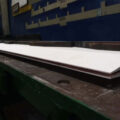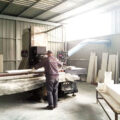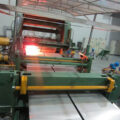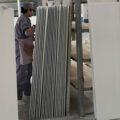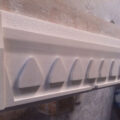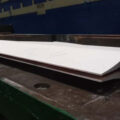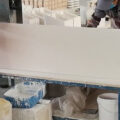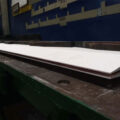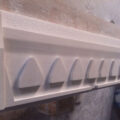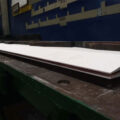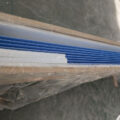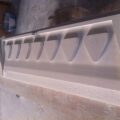Generally, the continuous casting process of molten aluminum is carried out on a commercial scale. The continuous caster process usually includes a pair of rotating water-cooled continuous caster rolls, in which the molten metal enters the rotating continuous caster roll through a feed caster tip and nozzle just before the production line closest to the continuous caster roll. By contacting the water-cooled continuous casting roll, heat is quickly extracted from the molten metal, and when the molten metal comes into contact with the water-cooled continuous casting roll, it freezes. Solid metal is compressed as it passes through the gap between continuous casting rolls, while the thickness of emerging metals depends on the narrowest spacing between continuous casting rolls. The thin metal sheet comes out of the caster rolls, and its width is a few meters and the thickness is about 1-6 mm (depending on the actual distance between the caster rolls). The speed of the casting process is about 1-4 meters per minute, and each operation can last for several days.

An important part of the casting process is the feed nozzle, which delivers the molten metal directly into the gap between two continuous casting rolls. This process usually places the top and bottom surfaces of the feed nozzle in direct contact with the caster rollers. Generally, the feed caster nozzle is made of a material that is harder and more corrosive than the steel caster material, such as alumina or alumina-silica fibers. The interaction between the movable continuous casting roll and the hard feed nozzle can cause scratches to be embedded in softer casters.
After the metal has solidified, when the metal passes and is compressed to conform to the thickness defined by the narrowest gap between the casting rolls, these scratches embedded in the casting rolls are again applied to the metal. The end result is the production of a continuous metal sheet with scratches, usually represented by raised ridges that extend above the expected thickness of the metal sheet, which is determined by the narrowest gap between the casters.
Currently, the only way to eliminate the scratches transferred to the metal plate during the die casting process is to use a feed caster tip and nozzle with almost no curvature. It can resist the absorption of water; and has the heat and strength characteristics required to successfully cast non-ferrous metals.

